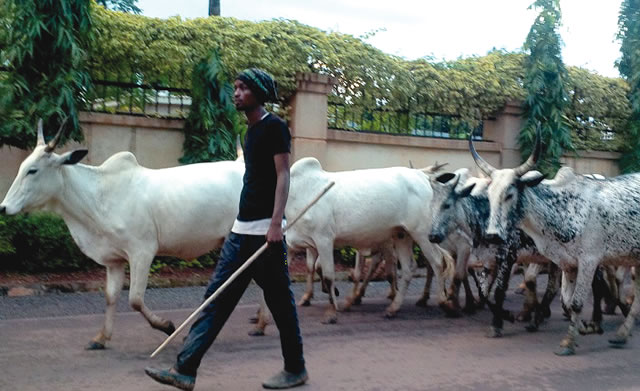By Ishaya Ibrahim
The Fulani tribe is Nigeria’s nomadic cattle herders known to walk hundreds of miles on foot with their flock for grazing.
This primitive animal husbandry is the source of Nigeria’s 19 million cattle heads, the largest in the African continent.
This is still insignificant when compared to the country’s population – 205 million people.
Nigerians consume a lot of beef as grilled, roasted or mashed. The market is huge.
In Lagos, 6,000 cows are consumed daily in a business transaction worth N1.8 billion.
The industry holds enormous potential benefits to Nigeria’s economy, but Africa’s largest market by population and Gross Domestic Product is still underperforming in this sector.
The Food and Agriculture Organisation (FAO) says that 30 per cent of the animals slaughtered in Nigeria are imported from neighbouring countries.
The last unemployment count by the Abuja based National Bureau of Statistics (NBS) estimates that 23 per cent of Nigeria’s labour force is without jobs.
But the FAO says Nigeria’s vast meat market can stimulate income for the country and employment opportunities for many unemployed Nigerians if well harnessed.
A livestock expert and chief executive officer of Livestock247ng, Ibrahim Maigari Ahmadu, said his organisation commissioned a survey in 2018 to ascertain the consumption of cow in the country.
“We discovered that there are four livestock Control Centres in Nigeria based on the Animal Disease Act of 1988.
“These Centres are supposed to control the transportation and assessment of livestock in Nigeria. One of the centres is in Makurdi in Benue State, one is in Nassarawa State. The two most popular ones are Lokoja in Kogi and Jebba in Kwara states.
“We calculated the number of cattle trucks passing these routes on a daily basis. 60 per cent of the trucks passing through Lokoja are certainly heading to Lagos while 20 per cent goes to the South East and the remaining 20 heads for the South South.
“The trucks heading through Mokwa-Jebba certainly circulates the South West. In one week, we recorded one thousand four hundred and fifty eight trucks of only cows with a truck carrying an average of 33 cows and that gives us a total of 38 thousand cows transported within a week to the South.
“Ordinarily, a cow costs an average of N150, 000. So if we calculate that amount in the values of 38 thousand cows, that gives us the sum of N7.2 billion in a week.
“It is now clear that certainly, the production of cattle comes from the north while the consumption takes place in the south,” he said.
A number of factors slow Nigeria’s cattle business. The Fulani cattle herders, the largest tribe of cattle herders in Africa, are a nomadic people who do not possess grazing land of their own. This inadequate access to feeds and grazing lands undermine the potential of the industry and breed insecurity.
The Fulani have lived in the Northern part of Nigeria since 1804 when Uthman Danfodio, a Fulani Islamic cleric conquered the area with his fighters.
For two centuries, the Fulani and their cattle have depended on the northern greenbelt for grazing. But those lands are no longer fitting for pasture. They have become desert fields, affected by climate change and deforestation. This has pushed the Fulani to the middle belt, an area dominated by Christians.
“The root cause of the nomadic herders and farmers clash is the competition for scarce resources (water and grass),” Ahmadu said.
Amnesty International reckons that between 2015 and 2018, at least 3, 641 persons have been killed in various clashes between Nigeria’s herders and farmers, 57 per cent of those deaths occurred in 2018.
Nigeria’s President, Muhammadu Buhari is Fulani, and every move his government makes to provide independent grazing lands for the nomads is viewed as an expansionist plot.
The government has probably not been pushing for the kind of solutions that are both acceptable to the farmers and herders.
The farmers maintain that it is either the nomads adopt ranching as means of herding their cattle or nothing. But the government thinks differently.
It first suggested creating grazing reserves in the entire country for livestock farming. It was rejected. It then pushed for cattle colonies. This time, the rejection was even more vehement. The government’s latest initiative, Rural Grazing Areas (RUGA), an acronym which is also a Fulani word for settlement, provoked bigger outrage. The move was quickly suspended to allow nerves to calm.
While Nigeria has yet to determine how to proceed with its cattle business, South Africa has shown to be a better example which Nigeria could copy from.
The country has 14 million cows in a population of 57 million people. It is a net exporter of beef products, a feat it first attained in 2016. The reason is that it adopts the modern ranching method of herding cattle.
In South Africa, the mean cow weight is 450kg, unlike the average Nigerian cow which weighs only 250kg at slaughter, data from the Food and Agriculture Organisation (FAO) shows.
Experts have favoured the National Livestock Transformation plan as an acceptable solution to Nigeria’s livestock industry.
The plan adopts ranching as the method of animal farming. In addition to economic benefits derivable from adopting the plan, it would also resolve the internecine between farmers and herders.











